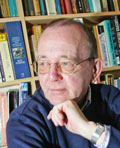I've done a few "keynote" presentations in my time. (A keynote is a major presentation at an academic conference/symposium/ or staff development session.) Not many, and it may say something that I haven't been asked back!
But there is something of a "circuit" of speakers and consultants in the field, rather like that of "standup" comedians. I'm not going to refer to any individuals in this post, and it is purely observational rather than critical; but last Saturday, sitting in the audience for yet another well-honed performance, I began to wonder about mission drift.
It's an occupational hazard. Successful presenters may do several a week, over several years. One of our deservedly popular regulars has probably been doing it since her first book came out 15 years ago. If she does one hundred a year now, having built it up over the years she will certainly have done her more popular performance more than a thousand times. I'm sure she reviews and revises it regularly, but there is a process of natural selection going on; the best bits get more prominence and more polish, and the less successful ones fade away.
Of course there is a process of incremental change. Recently there was a TV show about the comedian Peter Kay; it was a promotion for his new tour purporting to be a behind-the-scenes look at the preparations, and it was quite interesting to see the rehearsals with live audiences which refine the material in fine detail. But in that case the criterion for the inclusion of the material was simple—did it make the audience laugh?
Keynotes usually have a few laughs as well, but that is by no means their raison d'etre. It must be quite a challenge for the speaker to keep her or his eye on the ball, and to go beyond Kirkpatricks' first level of evaluation.
A colleague who couldn't be there asked me after the keynote what I thought of it. I said it amounted to less than the sum of its parts. Its arguments and coherence seem to have been weakened in favour of its set-pieces, whether one-man reconstructions of teaching encounters, or games with a group of the audience. They all made their points, but not a coherent whole.
It can happen with more mainstream lecturing; I developed a model for understanding aspects of residential homes in the mid-70s, and lectured on it for about 15 years (albeit only a few times a year). A version of it is here, in case anyone is interested. Except that in the early 90s, I realised that some of the anecdotes which provided the accessible evidence had taken over. Instead of a theoretical model it had become a string of stories, and it didn't mean anything any more. Even to me. I stopped using it, but I'm re-discovering aspects of its applicability to teaching.
Just for once, this may be an argument for using technology, so that the session does not have to be repeated live. Otherwise, the incremental drift may end up like those religious statues—initially polished by the hands or lips of pilgrims, but eventually worn away by them.
10 November 2014
Subscribe to:
Post Comments (Atom)



No comments:
Post a Comment
Comments welcome, but I am afraid I have had to turn moderation back on, because of inappropriate use. Even so, I shall process them as soon as I can.